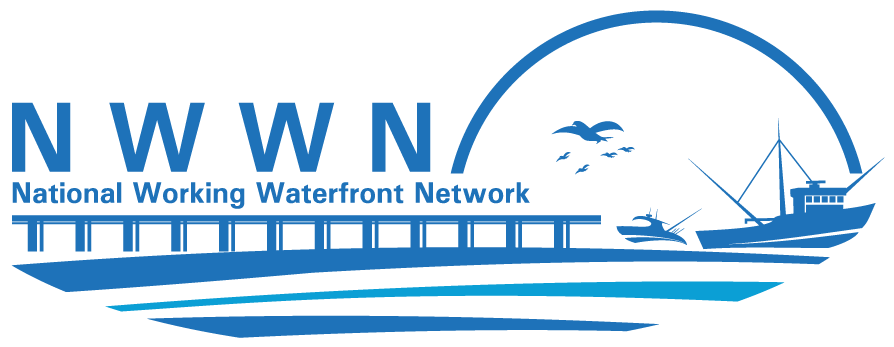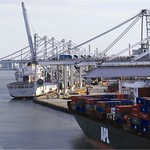Case Study
Addressing Working Waterfront Issues through the Governors’ South Atlantic Alliance, a Regional Ocean Partnership
Location
South Atlantic Region – North Carolina, South Carolina, Georgia, and Florida
Timeframe
2009 – present
Summary
In 2009 North Carolina, South Carolina, Georgia, and Florida along with various partners entered into a formal agreement, establishing a regional ocean partnership known as the Governors’ South Atlantic Alliance (GSAA). Working waterfronts is one of four Priority Issue Areas identified by the Governors to be of mutual importance to the sustainability of the region’s economic, cultural, and natural resources. As outlined in the GSAA Action Plan, the Working Waterfronts Issue Area Technical Team is charged with working toward balancing the needs of multiple waterfront stakeholders, and thus ensuring the viability of South Atlantic waterfronts. The working waterfronts portion of the GSAA Implementation Plan incorporates three objectives: enhanced capability of ports and waterfronts through expansion of infrastructure; preservation of traditional uses of working waterfronts by balancing public, commercial, port, residential, and military use; and determination of the viability of energy development of natural and human communities. By sustaining and enhancing robust cultural traditions, commerce, and use of public trust, the Working Waterfronts Team is addressing the goals set forth in the GSAA Action Plan.
Transferability
The GSAA Working Waterfronts Action and Implementation Plan could serve as a model for other coastal regions interested in addressing issues associated with working waterfronts, not only at the state level, but on a regional scale.
Best Practices
The Governors’ South Atlantic Alliance is a multi-state effort working at a regional scale to address four priority issue areas identified by the states. More specifically, the Working Waterfronts Priority Issue Area has fostered a strong regional partnership among the South Atlantic states that provides: – A structure and forum for collaborating, coordinating, and sharing information on a regional scale to address working waterfront issues; and – An opportunity for engaging in regional collaboration when fiscal and geographical limitations exist.
Full Case Study Description
Background
The South Atlantic states have a tradition of water-based activities that have influenced, and have been influenced by, the region’s economy, natural environment, and culture. The complexity of these interdependent issues experiencing rapid change creates new challenges and an urgent need for response. A growing understanding of the relationship of humans with the marine environment has led us to explore ecosystem-based approaches that engage multiple states. The situation calls for developing coordinated regional actions by the states, in cooperation with supporting partners, while leveraging multiple resources to help address critical issues and sustain the region’s shared marine systems.
The South Atlantic states saw successful approaches to regional partnerships in the Gulf of Mexico, Great Lakes, Northeast, and West Coast, and agreed that there would be value in establishing a similar partnership in the South Atlantic. In response, North Carolina, South Carolina, Georgia, and Florida along with various federal, academic, non-profit, and industry partners (see partner list below) formed a regional ocean partnership (ROP) known as the Governors’ South Atlantic Alliance (GSAA). The GSAA is working to increase collaboration to sustain and enhance the coastal and marine environment in light of economic, social, and national defense missions. By providing a forum for collaboration and coordination, the GSAA fosters cooperative actions and informs decisions that support effective planning and resource management.
The Southeastern states contain one-third of the nation’s 100 fastest- growing counties, with a majority of the growth concentrated in coastal counties. The Southeast coastal region contains 10 of the nation’s top 150 ports for tonnage and more than a dozen major coastal military installations including Marine Corps Base Camp Lejeune, Charleston Air Force Base, and U.S. Coast Guard District 7 in Miami. Challenges facing South Atlantic waterfront users include declining water quality, loss of public access and traditional uses, competing demands, and threats from coastal hazards. “Working Waterfronts” was identified by the GSAA as one of its four priority issues to provide regional solutions to these challenges. The GSAA is the only ROP to identify working waterfronts as a priority issue not only at the state level, but significant enough to warrant regional attention. The strong military presence in the South Atlantic region, as evidenced by the number of coastal military installations located here, and the importance of ports for commerce, were both important factors behind the designation of the Working Waterfronts Priority Issue Area. Additionally, the unique cultural population of the Gullah Geechee residing in this region, and the dependency of a large percentage of the economies of the South Atlantic states upon coastal tourism, factored into this decision.
History
The GSAA was formed on October 19, 2009 when the Governors of the four South Atlantic states signed the Governors’ South Atlantic Alliance Partnership Agreement. This landmark agreement established a regional ocean partnership with three federal co-lead agencies (NOAA, EPA, and DOI) along with numerous other partners that focus on addressing ocean and coastal resource issues. By establishing this voluntary partnership, GSAA promotes environmental sustainability, disaster preparedness, and strong economies in four priority areas: Healthy Ecosystems, Clean Coastal and Ocean Waters, Disaster- Resilient Communities, and Working Waterfronts, all of which were identified by the states to be of mutual importance to the sustainability of the region’s resources.
The GSAA leadership created Issue Area Technical Teams tasked with developing the GSAA Action Plan. Completed in December 2010, the Plan addressed the key environmental, economic, and cultural topics facing the South Atlantic coastal and ocean region. This was followed by the release of the Implementation Plan in July 2011, which included practical implementation steps for each action that required regional approaches and partnerships to be successful. These steps provide specific guidance for the region in accomplishing the goals set forth in the Action Plan, but with the flexibility to respond to new opportunities and address critical current issues.
Challenges
The Alliance has been successful in meeting some objectives; however, some challenges have threatened to derail progress including: 1) organization stability due to leadership changes at the state level (e.g., gubernatorial elections, fiscal administration); 2) continued funding support for programmatic implementation; and 3) consensus on the scope of regional efforts in a changing strategic and policy landscape (e.g., National Ocean Policy, Regional Planning Boards, shifting priorities in the states). Despite these challenges, communication has been essential to GSAA success, both internally to build good relationships among partners, and externally to keep stakeholders aware and supportive of the efforts underway.
Actions Taken & Approaches Used
The Working Waterfronts Issue Area Technical Team (WWIATT) focuses on economic and social resilience. A key component of their work is identifying how changing waterfront uses affect the resilience of coastal communities. The team seeks to sustain and enhance waterfront cultural traditions, commerce, and uses of the region’s waterways by supporting resilient coastal communities and economies. Composed of members from all four states, federal support partners, ports, marine trade associations and other partners, the Team tries to balance the needs of multiple waterfront stakeholders in the South Atlantic region. The WWIATT’s overarching objectives are to:
- Improve the capability and vitality of ports and working waterfronts through expansion of infrastructure and modes of access while addressing cargo and ship-borne invasive species, dredging impacts, and protection of natural resources.
- Ensure sustainable economic viability of working waterfronts while preserving traditional uses, including national defense, by balancing suitable public, commercial, port, residential, and environmental uses with best management practices.
- Address the viability and effects of energy development on natural and human communities and uses through planning and public education.
To accomplish these overarching objectives set forth in the GSAA Action Plan, the team developed an Implementation Plan that outlines specific priorities and related tasks to be addressed in current and future work plans.
Current Efforts & Next Steps
Port Capability and Vitality
Integrating regional long-range planning for both commercial and federal ports is an important focus for the Working Waterfronts Team. Through increased communication among member states, the team emphasizes multi- modal, multi-use capacity and promotes the use of existing infrastructure and navigational channels. For example, the team coordinated with the Atlantic Intracoastal Waterway Association (AIWA) to identify areas experiencing chronic navigational problems due to sedimentation, and prioritize those that could be alleviated by dredging. Information regarding the state of the Atlantic Intracoastal Waterway was collected, evaluated, and compiled into a report. The final task underway is to explore costs and other needs to achieve Waterway maintenance. The completion of this project will help make the GSAA more aware of challenges to the resiliency of local, regional, and state economies through impacts to working waterfronts.
Future plans include research and studies that forecast long-range needs of coastal ports and support community-based mapping of important working waterfront sites.
Working Waterfront Viability and Preservation
In order to limit the loss of recreational, commercial, and military waterfronts in the South Atlantic Region, the Team has worked with partners at the Department of Defense to identify sites that support military operations and training capacity, and made this information available to coastal managers and the public through the GSAA Regional Information and Management Systems portal (
www.gsaaportal.org/). The Team has been identifying and compiling data sets for public boat ramps, marinas, and ports for linking to the data portal, which is part of a larger effort to create an integrated database of all traditional working waterfronts and associated public access facilities in the region.
Efforts are also underway to develop a “Clean and Resilient Marinas” Initiative for the South Atlantic states adapted from an initiative developed in the Gulf of Mexico Alliance and implemented in Florida.
The Team plans to promote public/private partnerships, support the use of waterway and land-use planning and policy options, and promote the development of heritage and nature-based tourism opportunities to preserve working waterfronts in the South Atlantic Region.
Energy Development Planning and Education
The third working waterfront objective will be addressed based on the availability of funding and ability to dedicate resources. The WWIATT will plan for emerging industries by encouraging placement of the local workforce in new jobs through partnership with local education systems and ensuring proper training needs are provided to meet job requirements for emerging energy industries. The Team will also encourage adaptation of model land-use and water body management policies that address energy development issues by supporting development standards that are in concert with marine spatial planning, consistent with energy development needs, and balance environmental, social, and economic concerns. In addition, the Team will work to support “no net loss” of working waterfront access during development of offshore energy, particularly to sustain military training and operational capabilities, and by working with local governments to identify mitigation measures when loss is unavoidable.
Key Partners
National Oceanic and Atmospheric Administration U.S. Geological Survey U.S. Environmental Protection Agency U.S. Department of Defense – U.S. Navy/Marine Corps/Coast Guard/Army Corps of Engineers/Army FL Department of Environmental Protection FL Fish and Wildlife Conservation Commission GA Department of Natural Resources NC Department of Environment and Natural Resources NC Wildlife Resources Commission SC Department of Health & Environmental Control SC Department of Natural Resources SC Sea Grant Consortium University of North Carolina System South Atlantic Fishery Management Council Southeast Coastal Ocean Observing Regional Association South Atlantic Regional Research Program SE Regional Partnership for Planning and Sustainability The Nature Conservancy
Contacts
Kristine Cherry Coordinator, Governors’ South Atlantic Alliance kristine.cherry@gsaalliance.org Robert Swett Coordinator, Boating and Waterway Management Program, Florida Sea Grant rswett@ufl.edu April Turner Coastal Communities Extension Specialist, SC Sea Grant Consortium april.turner@scseagrant.org
References
GSAA website: www.southatlanticalliance.org; GSAA Action Plan (2010) (http://southatlanticalliance.org/wp-content/uploads/2013/12/12.17.10-Action-Plan-Final-with-Forward.pdf); GSAA Implementation Plan (2011) (http://southatlanticalliance.org/wp-content/uploads/2014/07/GSAA-Implementation-Plan_Final.pdf)
Last updated 05-Dec-14


